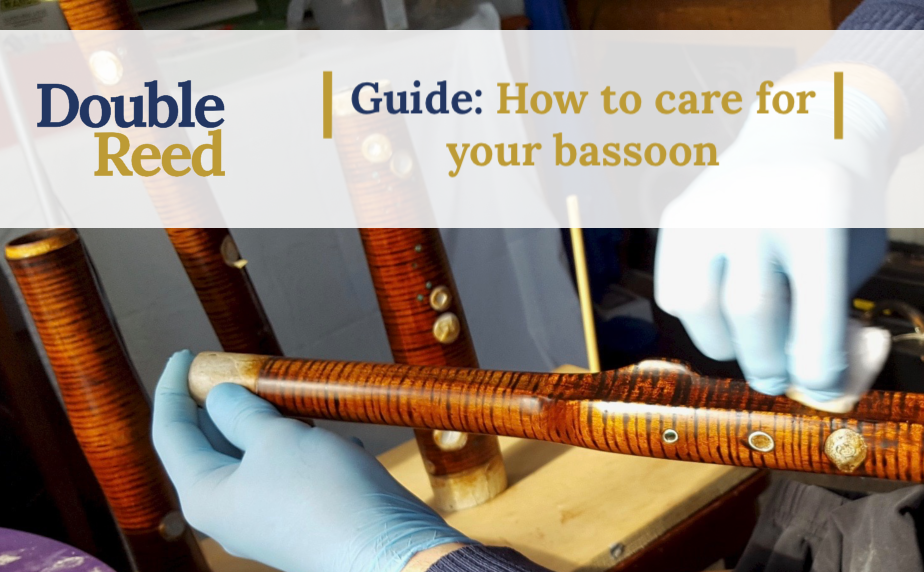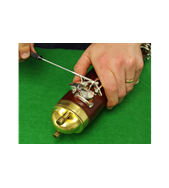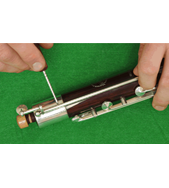How to care for your bassoon
August 23rd, 2018

How to care for your bassoon by Double Reed Ltd.
Article Author: Oliver Ludlow, In-House-Bassoon Specialist and Director at Double Reed Ltd.
The expected lifetime of a bassoon is, usually, longer than that of its owner. A well-cared for bassoon will last indefinitely; a neglected bassoon is liable to fall into disrepair, and if not restored, will become unplayable.
Maintaining the upkeep of your bassoon allows you to get the full potential out of the instrument – it will play more easily, it will sound as it should, it will need less restoration work throughout the course of its life, and it will hold its value more for if and when you come to sell it.
In this guide we cover the key steps to caring for and maintaining a healthy bassoon.
Swabbing the bores
The most fundamental regular task for maintaining a healthy bassoon is swabbing out the bores of the wing and boot joints after each use. As the bassoon is a wooden instrument, the moisture that accumulates inside when it is played will cause harm if not cleaned out promptly after playing. The moisture can cause the wood to rot, and will reduce the longevity of the leather pads on the instrument.
We recommend using pull-through swabs to clean out the moisture, and that the damp swabs are kept separate from the bassoon once it is packed away (to prevent the moisture remaining in close proximity to the bassoon). We do not recommend fluffy mops with a wooden handle. These leave fluff in the bore and tone holes, and the end of the mop often damages the U-tube when the mop is pushed too far into the bore.
How to pull through safely
- Remove the bell and long joints and place in the case
- Tip out water from the butt joint which has gathered in the U-tube. It is important to get the angle right when tipping the water out, to avoid water getting into the unlined wooden tone holes and unlined wooden bore on the large side. Hold the joint upright and then slowly turn it over, making sure the water runs out of the lined small bore
- Use a weighted pull through (there are a number of types available) to swab the boot joint out, dropping the weight into the large bore, shaking it around the bend and pulling it out of the small bore. Never pull the swab out through the large bore, as this will draw water into the unlined wooden side
- Use a second (dry), weighted pull through, to swab out the wing joint - pull it slowly to allow time for moisture to soak in
Note: make sure you check your pull through swabs for knots in the string or fabric, and remove them if present before use. Any knots can cause the swab to get stuck, especially in the wing joint. If your swab does get stuck, and won’t come out with a gentle tug, we advise you take your bassoon to a reputable repairer to have it removed safely with specialist tools. Continuing to pull can damage your bassoon. Never poke anything down the bore to try and rescue the stuck swab, as you will very easily damage the bore.
During the break
Never lie your bassoon across your lap, on the floor or across your chair during practise or when it’s not in use. Lying the instrument horizontally after it has been played causes water to run back out of the U-tube into the unlined wooden bore and tone holes. Over time this will cause the wood rot. Instead, keep the bassoon standing upright on your bassoon stand or safely in a corner of the room when not playing, or swab it out and put it in the case if there is nowhere safe to leave it.
The tenons
The maple wood bassoons are made from responds to environmental conditions, especially temperature and humidity changes. As a general rule, the wood will expand in the warm summer months, making the bassoon hard to disassemble, and shrink in the cooler winter months, making the bassoon easier to disassemble.
If you feel the corked tenons of your bassoon getting stiff when you assemble or disassemble the instrument, you may need to apply some cork grease to keep allow them to join together comfortably - forcing non-lubricated joints together can cause damage to the tenons of the bassoon, and keys are liable to bend owing to the extra force needed.
If the corked tenons are particularly wobbly, they are probably worn out and compacted, and should be replaced by a bassoon repairer - wobbly joints can leak, or even fall apart when the bassoon is picked up.
Note: never hold your bassoon by the bell joint only. It may come off and cause your bassoon to drop to the floor, especially if you have just greased it or the bell joint is loose. Instead, hold the bassoon by the wing and long joints combined.
If in doubt, any issues with your bassoon tenons should be looked at by a reputable repair technician who specialises in bassoons.
Note: some bassoons have cotton bound tenons. This works just as well as cork, and in many cases is easier to maintain. If your tenons are thread wrapped don’t use cork grease, as the cotton will soak up the grease, expand and cause the tenons to become tighter. Instead, you should remove some thread if the tenons are too tight, or add some thread if they are too loose. A good bassoon repairer will be able to show you how to do this. Always use natural cotton, not synthetic, as natural cotton is able to flex more as the wood naturally expands and contracts in response to temperature and humidity changes.
The Joints
The wooden joints of a bassoon are made from maple. While this is a hardwood, it is prone to denting and gouging if poorly treated. We recommend always handling your bassoon with care, and never putting it down on a hard surface or allowing it to come into contact with other hard objects.
Take particular care when putting your bassoon in its case – most surface damage to the wooden joints is caused by either an ill-fitting case or the bassoon not being put into the case with care. If the joints knock against each other in the case, we recommend using a soft cloth to keep the joints apart or, ideally, invest in a new case.
It is also a good idea to hoover out your case occasionally to stop any accumulated fluff or bits from getting stuck in the tone holes of your bassoon.
The pads
The pads of your bassoon tend to dry out with age, becoming stiff and misshapen - this will cause the pads to be noisy when pressed and will result in leaks as the tone holes will not seal properly. Pads that dry out over time, or rot owing to prolonged exposure to moisture, can cause tuning and intonation problems, and will require more effort from the player to project effectively.
Pads will need replacing ideally every 5 - 10 years, depending on how much you play, and swabbing the joints out regularly will help prolong their life. We also recommend using cleaning paper to absorb moisture directly from the pads after each use. Cleaning paper sheets are inserted under each pad, and the pads are gently closed onto the paper so that the moisture is absorbed.
The keys
Most keys nowadays are silver plated. In order to keep the keys shiny and smooth to play, and to preserve the life of the silver plating, they should be wiped after every playing session, and lightly polished with a silver cleaning cloth as soon as the shine starts to diminish.
Silver plating is harder than the underlying metal, so playing for prolonged periods on a bassoon where the silver has worn off is not recommended. Any reputable repairer will be able to re-plate one or more keys should they need it.
The hinges and mechanical connections of the keys of the bassoon shouldn’t rub or knock together when played – unlubricated keys are liable to wear out and become loose. If you can feel or hear evidence of the metal keys coming into contact with each other, a heavy key oil will need to be applied to lubricate the mechanisms and prevent metal rubbing against metal.
Unless you really know what you’re doing, we don’t recommend removing the keys to apply the oil yourself – this should be done by a reputable bassoon repair technician.
The crook/bocal
When inserting the crook always hold it just above the cork, to minimise pressure on the bend of the crook, which is surprisingly easy to bend. If it is too tight, use cork grease to ease it in or sand a little cork off. If it is too loose it may leak and move while you are playing, so a bassoon repairer will need to fit a new, thicker cork.
Your crook should be cleaned at least once a month using a crook brush and warm, soapy water – neglecting to do so is unhygienic, and will impact the bassoon’s sound and playability.
To help prevent bacteria forming inside the crook, a crook swab should be used to remove moisture after every use.
An annual service
The bassoon is a complex instrument, being made up of many moving parts and consisting of material that is susceptible to damage if not maintained carefully. All bassoons need an annual service to ensure that they are playing to their optimal level, and to catch any problems before they progress and become more serious.
The bassoon differs significantly from other woodwind instruments and many general woodwind repairers have little experience of bassoon servicing and repair, and so we highly recommend taking your bassoon to a reputable repair technician who specialises in bassoons.
Article Author: Oliver Ludlow, In-House-Bassoon Specialist and Director at Double Reed Ltd.



